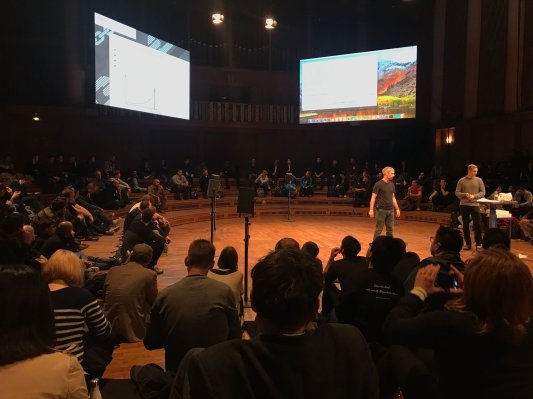While the blockchain world has seemingly blazed along in the last 18 months, much of the action has been in the currency world. The underlying technologies building this world are growing at an equally blistering rate, but until now few have threatened to ‘game the game’. Today at the Web3 Summit in Berlin, Parity Technologies founder Gavin Wood demoed launching a blockchain in under 60 minutes, a previously unheard-of feat. Although it was hard to ascertain the demeanor of the quiet, and often subdued crowd of hardcore, hoodie-wearing blockchain developers arraigned before him in the vaulted, wooden paneling of East Berlin’s old DDR-era symphony hall, the excited chatter in the hallway after the presentation was palpable.
In a grand gesture, Wood launched a new blockchain in about 15 minutes from a brand new Mac laptop, from which he dramatically tore off the shrink wrap, in order to demonstrate how little time and set-up it would take, and how few tools would be needed to pull off what might previously have taken days or even longer, depending on the complexity of the project. Developers sitting in the front row of this live demonstration literally gasped as Wood fired-up the platform.
While startups – whether web, mobile, crypto or blockchain-based – routinely launch themselves literally from software built for the last 25 years, the blockchain world, with its many idiosyncratic ways of creating new products, has not had the same luxury. Polkadot, under Wood’s tutelage, seems on the brink of changing all that, and the summit clearly understood the ramifications.
Parity’s Substrate 1.0-beta will be out in November 2018, and, he says, will be “the biggest bet against blockchain maximalism.” Decoding that in his speech, he said the industry had become too “nationalistic” about one type of blockchain beating another: “Maximalism creates barriers to entry and reduces the fun for technologists,” he said.
Substrate, which is the foundation for Polkadot (a ‘para chain’ aiming to act as a link between many different types of blockchains) will now come as a standalone blockchain framework. This will allow developers to build highly advanced blockchains customized for any project. And that, say seasoned observers who spoke to TechCrunch, is ‘game-changing’ and could radically accelerate the development of blockchain technologies.
In a statement, Parity explained that while Polkadot and Substrate share a goal to spark new a wave of blockchain innovation, they remain two distinct technologies. Substrate, says Parity, is “like the software or PC” that people choose for their application, whereas Polkadot, a protocol that connects blockchains together, “is like plugging a network card into that computer”.
Substrate, they say, will give blockchain innovators the framework for “maximum freedom with minimal effort” as it is “highly customisable, adaptable, and made by blockchain developers for blockchain developers”. It allows developers to focus their effort “on the thing they care most about — the state transition function,” while providing them with the networking, consensus and security as well as an upgrade path to interoperability with Polkadot.
Additionally, Substrate promises a future where developers won’t have to wait for (for instance) the core team that controls the development of Ethereum, to implement improvements. The idea is that they can build what they want to build, knowing that Substrate is ‘generic’ enough to be able to fit with new versions of Ethereum that come down the line.
Asked to unpack this by TechCrunch, Wood said on stage: “All of the lessons we learned developing Ethereum and Polkadot have been distilled down into a single stack of tooling that allows you to get all these advantages, in terms of time, cost and money. How well this works is going to be dependent on us. But it’s my hope that when we put out Substrate 1.0 this will be a turning point that makes the promise of a multi-chain world a captivating one… I hope this creates a new class of developers that sits in the sweet spot [between low and high skilled developers], where you can do just enough that allows you to get a job done and well without having to create your own blockchain.”
At the conference, Wood also announced that the Substrate software will be relicensed to Apache 2, which will “instantly open the door to all of the Fortune 500 to actually experiment with it.” He also presented a new Polkadot design that, he says, allows for “infinite scalability.”
Commenting, Trent McConaghy, founder of Ocean Protocol and also a speaker at the conference, said that with Substrate, Pokaldot had just made the whole blockchain developer ecosystem jump forward “between 2 and three years”.
Attendee Keld Van Schreven, partner of blockchain project investor KR1, said: “It’s like being able to generate HTML pages without having to know HTML. In the Web 1.0 world that was transformational to the early Internet ecosystem. Substrate will make it much easier to deploy blockchains. And the Lease model means there is a quality control there. What they’ve done here is extremely hard, technically. They just made it look easy.”
